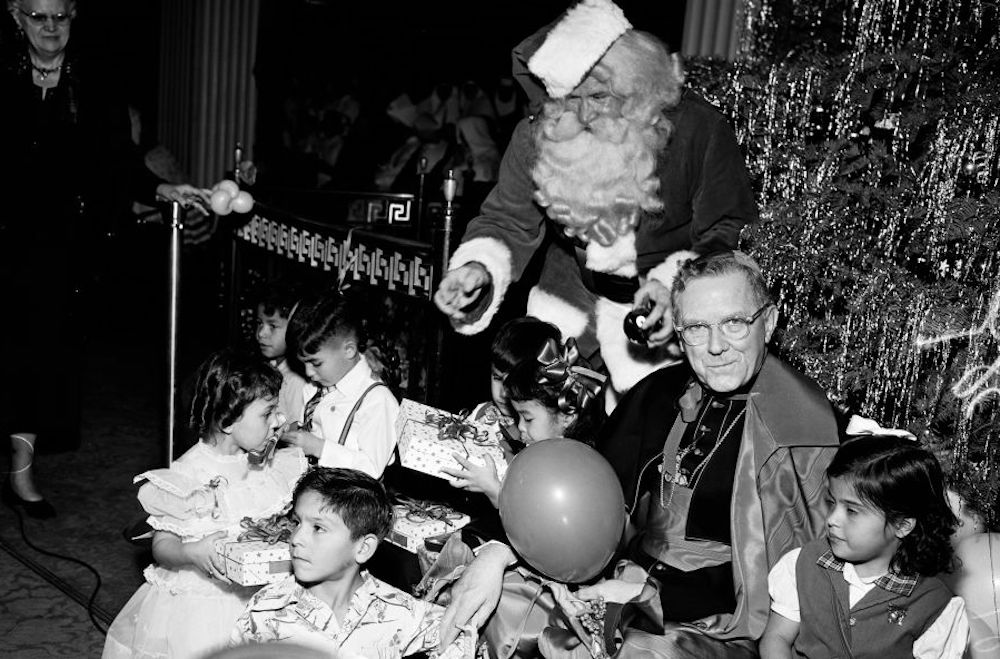Defending the Secular Vision of Christmas

You may have learned in a college course on the history of advertising that Santa Claus was invented by 19th century New York cartoonist Thomas Nast. Others consider the Ghost of Christmas Present to be the genesis of the modern Santa. The roots of Santa Claus go all the way back to pagan Germanic folklore or to an actual 6th century Saint Nick, or both. But there’s no question that Nast, and the Nast-inspired portrait of a Coke-chugging Santa, is the most immediate template for the fat, jolly man who symbolizes the secular version of Christmas in which good tidings of great joy are plentiful, but not inspired by anyone or anything in particular.
For a long time it felt like secular Christmas did not so much compete with the religious version, but complement it or harmlessly parallel it. It was a civic, American phenomenon, a universalized version of the Christian holiday, not mutually exclusive from it. Those who have grown up during the “war on Christmas” era, or who view “Season’s Greetings” as a secular affront, might be surprised that the Eisenhower White House’s 1957 Christmas card was bannered with exactly that salutation.
That same year, C.S. Lewis penned an essay on the meaning of Christmas, or rather, on three of them: the religious event, the jolly season, and the “commercial racket,” which is “good for trade.” The first two are perfectly compatible with each other, he argued, while the third one is destructive of both, a sentiment that may have been prescient rather than obvious back in the ’50s. Lewis’s essay nonetheless demonstrates that neither the secularization nor the commercialization of Christmas is new.
Tell that, however, to Donald Trump (superseding “War on Christmas” commander-in-chief Bill O’Reilly), whose campaign this season is selling merchandise emblazoned with the bold slogan “We’re Saying Merry Christmas Again.” Who the “we” is, and when alternatives to “Merry Christmas” went from Eisenhower-approved to liberal doublespeak, is left to the right-wing imagination.
In a similar vein as that Eisenhower greeting is the larger mid-century cultural phenomenon of the Jewish Christmas song. In some ways, this is a microcosm of what was best about the ’50s; out of the rubble of the depression and the war, a relatively easygoing, vaguely Christian but functionally secular national culture arose. There is more outrage today over plain red cups and “holiday” catalogs than there ever was over Jewish songmakers who turned Christmas into something about chestnuts and shiny-nosed reindeers. And that’s exactly as it should be; Christmas may be about Christ, but in a great big diverse society there is no reason why it may not also be expanded and universalized—as C.S. Lewis understood.
It should be noted that a close look through the history of Christmas in America dispels the idea that conflict only arose in the last two or three decades. For example, just as some Birchers viewed Eisenhower as a closet communist, there were indeed far-right, anti-Semitic Christians, like firebrand Gerald L.K. Smith, who saw the secular version of Christmas as a “Jewish plot” to erase Christ from the public square. There were also plenty of disputes and court cases over public displays involving nativity scenes, for example, as far back as the middle of the 1950s. (No such case reached the Supreme Court, however, until 1984). But all of this was marginal in those days. If the Jewish-plot theory had been mainstream, secular holiday albums would not have abounded in those years, and Rudolph would have never made the jump from department-store issued children’s book to beloved holiday special.
When, then, did the multiplicity of Christmases become a problem? Why are outrages against the sacred holiday now a kind of perverse glee by angry Christians?
The mid-century cultural moment was unstable and is not coming back; indeed, very few popular Christmas songs have been written after the end of the postwar era. But we can more correctly view the Jewish Christmas song of the past not as an appropriation of a Christian holiday, but as an act of positive cultural creation and accommodation. What we got from that arrangement was a body of work that to this day brightens the season, complements rather than denies its specific religious meaning, and avoided a culture war in a country that was sadly not ready to fully accept Jews.
In later years, the imagined villain of secular Judaism has been replaced by the somewhat more real villain of killjoy atheists, who helped spark the exaggerated “war on Christmas” narrative with their anti-creche lawsuits and “This Season, Celebrate Reason” billboards, which, despite their diametrically opposite message, resemble nothing so much as a “THERE IS EVIDENCE FOR GOD” billboard along the Interstate.
The Randians, not to be outdone, are happy to reject the Christians and the anti-Christians, and remind us that Christmas was really about selfishly buying cheap junk all along.
All of this is happening in a country in which reducing religion to Christians and Jews makes as little sense as reducing race to black and white. Our diversity is vast, and arguing over which holiday greeting a minimum wage checkout clerk has to say 1,000 times a day is a ticket to irrelevance. “Merry Christmas” should come naturally and joyfully, a part of a shared national experience; it should not, like Ted Cruz’s “radical Islamic terrorism,” be a talisman and litmus test in a culture war.
In fact, we can no longer afford a culture war at all. The only one of C.S. Lewis’s three Christmases that has survived the last 60 years unscathed is the one he detested. As our cultural squabbles drag on, we have allowed the market to appropriate and expropriate the Christmas holiday of much of its religious and civic meaning. Whether you’re on Team Jesus or Team Santa, that’s nothing to be merry about.
Comments